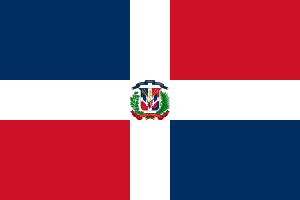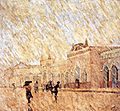Dominican people (Dominican Republic) facts for kids
 |
|
| Total population | |
|---|---|
| Dominican people 13,263,000 Total population of Dominican Republic |
|
| Regions with significant populations | |
| 13,263,000 | |
| 2,000,000 | |
| 120,000 | |
| 100,000 | |
| 88,500 | |
| 63,000 (in scattered places) | |
| 49,000 | |
| 30,000 | |
| 22,000 | |
| Virgin Islands (USA or Britsh) | Unknown |
| Unknown | |
| Unknown | |
| Languages | |
| Spanish | |
| Religion | |
| Roman Catholic; Protestant, Dominican Vudu, Santeria, Other African regligions. | |
| Related ethnic groups | |
| Other Latin Americans (As well as other Caribbean or West Indian peoples). | |
Dominicans (Spanish: Dominicanos) are people who live in or are citizens of the Dominican Republic. This country is located in the Caribbean Sea. The Dominican Republic is a special place because it is home to people from many different backgrounds. This mix of cultures and origins is something many Dominicans are very proud of.
A Mix of People and Cultures
The Dominican Republic has a rich history of people coming from all over the world. Many years ago, between 1717 and 1870, a large number of enslaved Africans were brought to the island. They came from various parts of West Africa, especially from the Congo region (like modern-day Angola and Gabon) and the Gold Coast/Guinean areas (like Ghana and Guinea).
Over time, many other people also moved to the Dominican Republic. After 1898, people from China arrived because of big changes in their home country. People from North Africa (like Morocco and Algeria) and India also came. Later, during the late 1800s and early 1900s, many Europeans, especially from Spain, Italy, and Germany, settled there. They often made their homes in the capital city, Santo Domingo, or in the countryside of the Cibao valley.
During World War II, the Dominican Republic was the only country that welcomed many Jewish refugees from Germany and Austria. About 800 of them found a new home in a town called Sosúa.
Today, most Dominicans have a mixed background, often called Mulatto. About 73% of people in the Dominican Republic are considered Mulatto, 16% are White, and 11% are Black. Studies show that about 15% of Dominicans have ancestors from the native Taíno people on their mother's side. This number is even higher in rural areas. Other studies suggest that the average Dominican person has about 53% European (mostly Spanish), 39% African, and 8% Taíno heritage. These numbers can change depending on which part of the country you look at, as people of African descent are more common in the southern and coastal regions.
Images for kids
-
Map of the Dominican Republic
-
Dominican Republic people in the town of Moca.
-
Iglesia Sagrado Corazón de Jesus in Moca, Dominican Republic.
-
People attending mass in Cathedral of Santo Domingo.
-
Dominican native and Major League Baseball player Albert Pujols
See also
 In Spanish: Dominicanos para niños
In Spanish: Dominicanos para niños

























